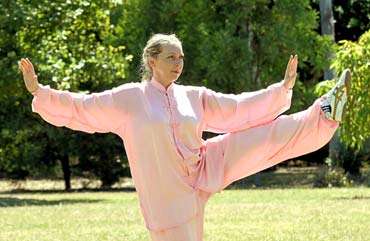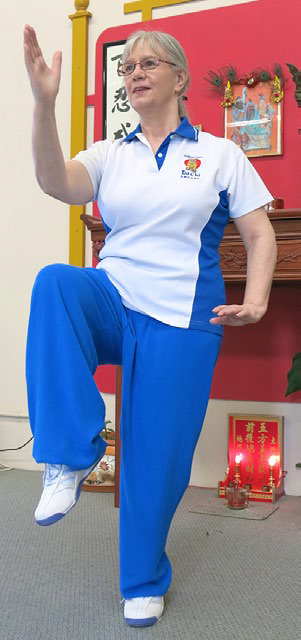Gives tips on using Tai Chi essentials to further improve balance and stability. Tai Chi is recommended to improve balance and stability, it combines aerobic warm-ups, balance exercises and training, movement training with mental focus. In this article, Golden Lion Tai Chi student Keri Boyd outlines some of the ways to improve your balance.
Using Tai Chi to Improve Balance
In the last few years I have developed more arthritis and joint problems and my balance in Tai Chi has become a challenge. In an effort to improve my stability for Tai Chi I searched the internet for strategies to assist in improving my balance. I discovered there is a great deal of information available on-line in relation to improving balance and stability, including information about research in the field of maintaining and improving balance and stability in the ageing population.
There are many strategies recommended for improving balance and stability ranging from regular walking programs, exercises to increase flexibility and aerobic fitness, exercises to build strength in leg and core muscles, and using equipment such as weights, balance balls and balance boards to stand on.

I was particularly interested by an article by Lance Dallek, Ph.D, who advises that ‘multi-component’ training is superior to ‘single component’ training for long-term balance improvement. Dr Dallek recommends that a well-designed balance program should include ‘concurrent’ cognitive, flexibility and aerobic tasks along with the strength and balance exercises to optimise the long-term results of balance training.
Dr Dallek’s article gives and understanding why Tai Chi is a recommended strategy for people seeking to improve balance and stability. Tai Chi is an excellent example of a varied form of balance training that combines aerobic warm-ups and balance exercises as well as movement training with complex mental focus. The slow, low-stepping movements of Tai Chi includes the waist moving from side to side, arm positions constantly changing, reversing directions, one leg stands and low sweeps and are a constant challenge both to the mind and body. The stances can be lowered to increase to strength building in the legs and the one-leg stances and kicks challenge the core muscles. The mind and the body are working together to perform a complicated routine controlling speed, breathing, constantly shifting directions and balance while maintaining mental focus.
The Tai Chi student continues to be challenged mentally while practising balance in a multi-tasking format as recommended by Dr Dallek so that shifts of balance and movement recovery become second nature. Tai Chi has so many levels of improvement, different forms, routines, styles and different weapons to challenge the mental and physical capabilities that students will not become bored with repetitive exercises.
In seeking to improve my balance for Tai Chi I also looked more deeply into the techniques taught to us in the 10 Essentials of Tai Chi and I discovered that these are powerful tools in maintaining balance.
These are my tips for using some of the Tai Chi essentials to further improve balance and stability:-
- Straighten the head – Keep the chin level with the floor, reach the top of the head up to the sky and look straight ahead. This helps to stretch out the hunched ‘desk’ posture and lengthen the spine and align of points allowing the flow of qi and improves balance.
- Correct position of chest and back – Make a soft turtle shell- engaging the core muscles, sink the chest, round the back and slightly tuck the tail under. This turtle shell gives a sense of strength and helps to open up the spine and align ming men and improve flow of qi.
- Relaxation of waist – A little wriggle of the rib cage can loosen and relax the waist to allow the waist to move freely and smoothly. This allows the waist to be loose so the upper body and arms can turn and deflect while being supported by a solid leg stance.
- Solid and empty stance – The substantial leg should feel solid and strong allowing you to ‘sit’ on the hip joint to fully support your weight allowing the empty leg to move and replace without the shifting of weight. Moving slowly through the change from empty to solid through the horse stance gives greater feeling of strength and stability. Sensing the gradual movement of the pressure through the foot as the weight moves slowly from one leg to the other helps to train the brain in extra ‘calibrations’ of balance awareness.
- Sinking of shoulders and Elbows – Rotate the shoulders up and back whi

Keri Boyd demonstrating tai chi to improve balance le breathing in and breath out while completing the downward circle. This helps to relax the tension in the upper body and lower the centre of balance. Having the elbows pointed down helps the shoulders from rising up again.
- Using the mind instead of force – Using the mind to help improve balance can be very simple and effective–
- Consciously slowing the breathing and imagining the breath being pushed down to the dantien helps to lower the centre of balance and draws the focus inward away from daily stresses and outside distractions.
- Imagine a ‘hitching post’ about two fists away from the dantien to add support for leg raises.
- Imagine a big helium balloon tied to the ankle to support the elevated foot for kicks.
- Think of a strong magnet drawing the dantien forward to help recover from overbalancing backwards.
By practising Tai Chi and using the Tai Chi essentials I am gradually increasing flexibility, building muscle strength, smoothing weight transfer and conditioning my balance awareness. Combining an upright posture, stronger use of legs, slow, smooth, circular movements and turning from the waist (not the head) gives me greater stability.
Tai Chi improves my physical condition while providing mental stimulation and the excitement of learning new forms and weapons keeps me coming back for more Tai Chi and aiming higher.
Reference: Article by Lance Dallek, PhD.
https://www.acefitness.org/certifiednewsarticle/687/designing-balance-exercise-programs-for-older/
